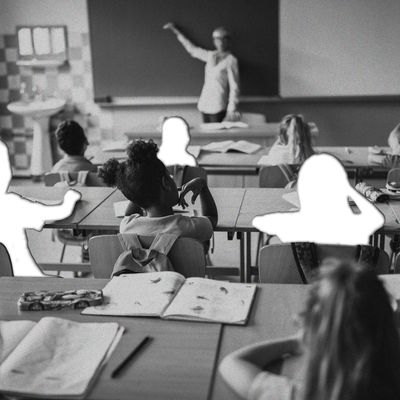
Days after President Donald Trump’s inauguration, Ginny and her colleagues at a high school in North Carolina welcomed two new students who had recently come to the U.S. from a Spanish-speaking country. The teens enrolled in the English as a second language (ESL) program that Ginny teaches and went to the library to pick up a school-issued computer. “My colleague was telling them, ‘You keep this laptop and you give it back if you transfer schools or when you graduate,’” she says. “Then one of the kids replied, ‘And what do we do with it if Trump gets us?’”
The president’s mass deportations pledge has caused a level of anxiety among Ginny’s students that she’s rarely seen in the more than 15 years she’s been teaching ESL. (Ginny and the other educators in this story asked us to withhold their full names to protect their privacy.) Some students are making jokes about being deported, in what Ginny sees as an attempt to mask their panic. Others have asked her what will happen if ICE detains their school bus, or if agents show up to their homes or workplaces. Parents have even told Ginny they are considering keeping their children at home and asked whether they can take their ESL classes online. “There’s deep-seated unrest, not unlike when we would have a code red at school because a gun was found on campus,” she says. “I can’t teach students who don’t feel safe.”
For 14 years, U.S. Immigration and Customs Enforcement had a policy preventing agents from making arrests at schools, churches, and hospitals—locations that the government considered “sensitive” areas. But within two days of Trump’s return to the White House, he directed ICE to resume arrests at these previously off-limits locations, with the Department of Homeland Security saying, “Criminals will no longer be able to hide in America’s schools and churches to avoid arrest.” (The administration considers any immigrant without status a “criminal,” even though being in the U.S. without authorization is a civil violation.)
In response, schools across the country are instructing staff not to report students to immigration agencies, implementing “secure perimeter” protocols to prevent people from coming in or out, and offering Know Your Rights sessions for parents. While there have been no official reports of ICE actions at K-12 schools so far, confusion and rumors have spread in recent weeks. In Chicago, an elementary school reported that officials had turned away immigration enforcement agents before quickly retracting that statement: It turned out that Secret Service agents had come to the school to investigate a threat allegedly made by a 12-year-old. There’s also the concern that school staff may report students or their families. One Texas school district opened up an investigation into a substitute teacher who reportedly called for ICE to come to a high school where 93 percent of the student population identifies as Latino.
C, a high school teacher in New York City, says some of her students who come from families with mixed immigration status and are on the way to college are considering not applying for financial aid in order to protect themselves and their families. “There’s a rumor going around that they’re going to use their information from the FAFSA to get their parents,” C says. “I’ve been trying to reassure them and tell them that Trump can’t get away with all of this. But every single day he’s doing something new—it feels like I’m lying to them because I can’t protect them.”
The city’s Department of Youth & Community Development (DYCD) recently met with staff at C’s school to go over protocol in the event ICE agents show up. She says the department told staff that they should comply with agents only if they have a warrant signed by a judge, because resisting it could open up staff to legal issues. “I didn’t like the fact that they used the phrase ‘harboring students,’” C says, referring to the charges uncooperative staff could face. Administrators told staff that if ICE does come to the school, agents will be stopped at the door and rejected regardless of what warrants they may have, but that assurance did little to assuage C’s concerns. Staff had already been instructed by DYCD not to warn students if ICE agents came to campus, and her classes go on frequent field trips that she worries could put teens at risk.
“You wanna stand up for these kids,” she says. “What do I say? Ok, go with the agents? I’m going to say no. If I get in trouble and if I get arrested, so be it.”
Araceli, a volunteer at an after-school program in St. Louis is also worried about the threat of raids. The tutoring center serves many recently-arrived, elementary-school-aged Latin American children who need support improving their English. The program’s director gave the team several directives recently in preparation for potential ICE actions, according to Araceli. First, tutors should not initiate conversations with the children about the current immigration landscape. Second, the director will be the only person answering the door. And third, the kids will no longer be allowed outside for “sensory breaks” when they’re getting rowdy or struggling to pay attention. “The director said we don’t want to bring attention to ourselves,” Araceli says. “In other words, we don’t want to expose that there’s a lot of brown children that are playing outside—that was my takeaway.”
While St. Louis officials have said they’re not in contact with ICE, Araceli says she heard a rumor that agents recently showed up to a local health clinic that caters to immigrants in the neighborhood. The children she tutors, she adds, seem largely unaware of the anxiety blanketing the community. Because the after-school program does not ask about families’ immigration status and it’s not clear who could be at risk, Araceli printed out Know Your Rights “red cards” so the director could distribute them to every parent. “It’s heartbreaking because I’m a child of an immigrant and I know what it’s like to feel this kind of uncertainty,” she says. “But I also feel grateful that I’m here and I’m able to help in any way that I can.”
Araceli is concerned that parents will withdraw their children from the program if more raids occur. In North Carolina, Ginny is also worried about what will happen to her students if they stop coming to school. “I can try to encourage them to come back, but I can’t make any guarantees about what would or wouldn’t happen,” she says. “It was already hard enough to entice kids to stay in school, to make them think that getting a high-school diploma could help them in the future, even if their immigration status was uncertain.”
“Any immigration-enforcement action would be a breach of trust that really couldn’t be rebuilt between the community and schools,” she adds. “All of this seems like bully behavior.”


